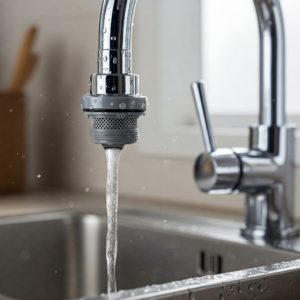A Faucet aerator is something that every efficient plumber should know about. They are small but very necessary parts of every faucet set up. They help with water savings and water flow. Without an aerator, water causes unnecessary splashing, and water sprays out with uncontrolled force. Sometimes these small parts become worn out and need replacing. Thankfully they come in different variations to accommodate your daily needs.
What is a faucet aerator?
Aerators are small, round devices that you can screw onto the tip of your faucet to create a more consistent, splash-free stream of water. They create a smoother mixture of water and air. They also will limit the water flow. Have you noticed that water from some faucets feels soft to the touch? This is made possible by an aerator.
What is the purpose of a faucet aerator?
They first were introduced in the late 1940s as add-on devices to reduce water splashing and help water taste better by introducing oxygen. Aerator comes from aerating which means introducing air into something (in this case water). As air is mixed with water it reduces the flow rate of water without affecting water pressure. This means that you will not notice the water volume difference despite the reduced flow rate. This helps save you money when it comes time to pay the bills. In fact, according to the EPA, installing faucet aerators is the single most effective water-saving plumbing change you can make.
Does A Faucet Aerator Require Maintenance?
Because most aerators use a plastic or metal mesh screen, it is important to keep the screens clean as they can become clogged with silt and minerals over time. Simple brushing and rinse will suffice if there are no blockages. A soak in a water-vinegar solution for multiple hours may be required for trickier clogs.
How Much Water Can An Aerator Save?
A 1.0-gallon per minute (GPM) aerator can save more than 50 percent of the water you use vs. a standard 2.2 GPM faucet aerator. You can save anywhere from 2 to 16 gallons of water per day based on the aerator you choose to install. They also reduce the level of hot water consumption as well, which means that your water heater is used less frequently saving you money and energy.
Choosing the correct type of aerator depends on the choice of water flow and type of water stream. Most aerators can provide an aerated stream that is wider and whiter and at the same time, it is non-splashing and soft to the touch.
Other types of streams include spray and laminar streams. Spray streams are made to reduce water flow but provide wide coverage. These streams produce a pattern similar to a showerhead and are ideal for handwashing.
Laminar streams give out 100% water and are usually installed in places where high water flows are needed. These streams are usually non-aerated and are crystal clear. These streams are non-splashing as well.
Although aerators are small they can help us preserve and manage our most important resource. These are very simple tips that make a huge impact on your wallet and the environment.
Benefits of Faucet Aerators
✅ Water Conservation – By adding air into the water stream, aerators reduce water usage without compromising pressure. This helps lower water bills and conserve resources.
✅ Improved Water Pressure – Aerators help maintain steady pressure while reducing overall water flow, preventing splashing and ensuring a smooth stream.
✅ Better Filtration – The fine mesh inside an aerator can catch small debris, preventing contaminants from entering your water supply.
✅ Energy Savings – By reducing the amount of water used, aerators also cut down on the amount of hot water needed, leading to lower energy costs.
Do You Need a New Aerator?
If your faucet has low pressure, uneven flow, or excessive splashing, it may be time to clean or replace your aerator. Contact Option One Plumbing today for expert advice and installation!

